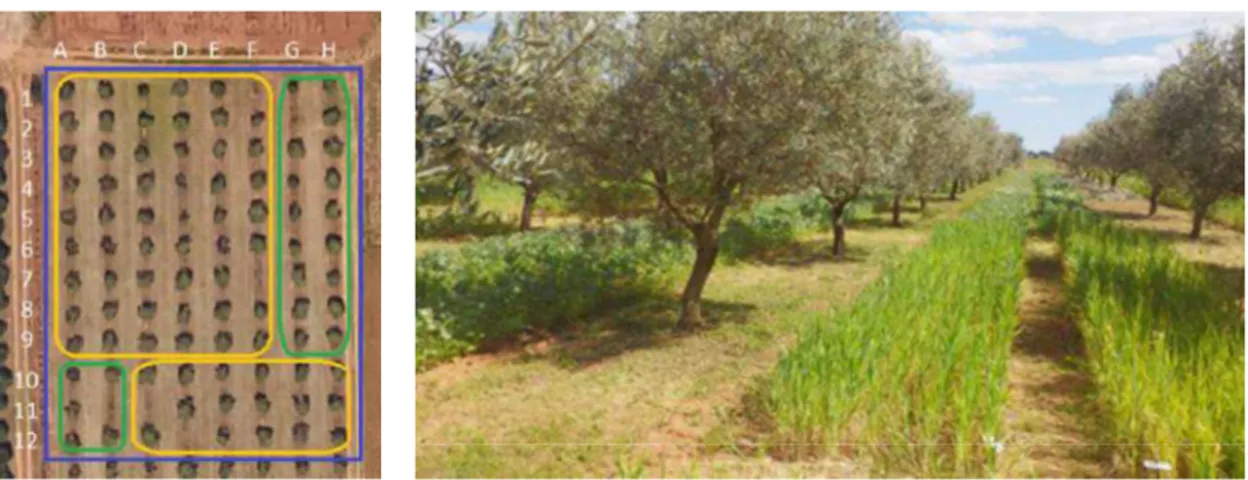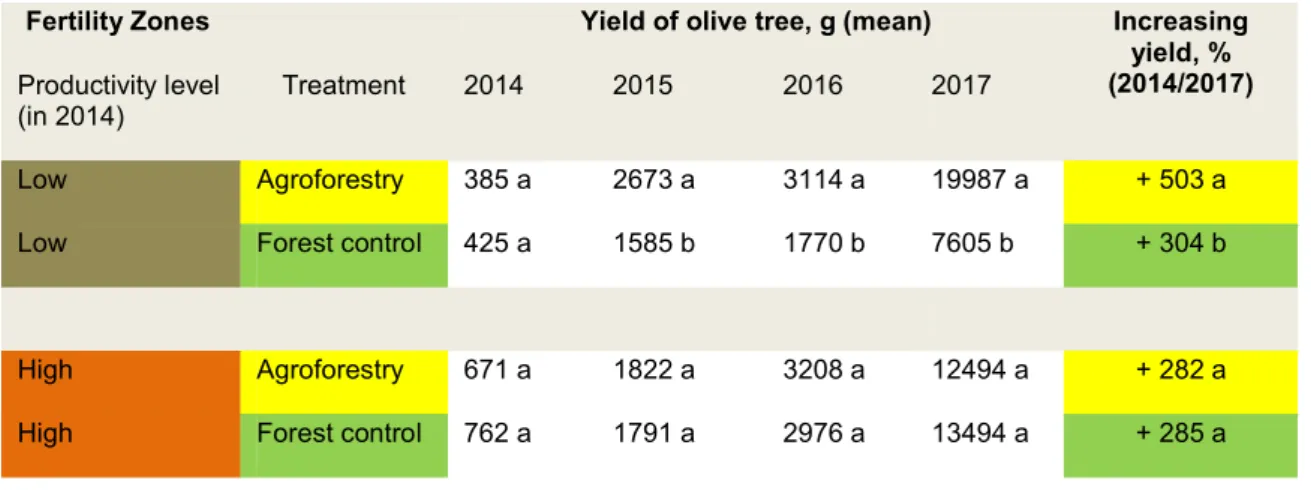DURUM WHEAT IN OLIVE ORCHARD: MORE INCOME
FOR THE FARMERS?
Panozzo A1, Desclaux D1*
(1) DiaScope- Inra Domaine de Melgueil-34130 Mauguio, France *Corresponding author: dominique.desclaux@inra.fr
Abstract
The present study arises from the difficult sustainability of organic olive orchards in Mediterranean areas that present usually a low productivity. Literature provides examples of increased olive productivity when associated to understorey crops but mainly cover crops. This study highlights that, (i) it is possible to grow field crops in an abandoned olive orchard without ploughing to avoid olive root damages, (ii) agroforestry can improve the olive orchard profitability by implementing a crop rotation based on durum wheat and legumes. Since they are yearly pruned, Olive trees increased progressively their productivity and the associated durum wheat provides an additional source of income to the farmer. Furthermore, if durum wheat varieties adapted to agroforestry conditions would be provided by breeders, they could reach higher yield when associated with olives and thus increasing the orchard sustainability.
Keywords: agroforestry; oil market, breeding; sustainability
Introduction
Olives and olive oil are the key basis in the healthy Mediterranean diet and the demand is increasing for such products coming from sustainable and organic farming (Afidol 2015). Most often organic orchards are zero input ancient orchards located in extensive hilly and mountainous areas susceptible to soil erosion (Taguas et al. 2010). These low-density olive orchards present a low productivity and therefore are progressively abandoned (as described in the EU Olivero project: Duarte et al. 2008). High-density olive orchards have been spreading over flat Mediterranean regions in order to get advantages from fertile lands and better condition for agricultural practices (Pastor et al. 2007). But, they usually need the use of chemical treatments and are therefore not totally compatible with the organic regulation. Moreover, despite the increasing production, this system does not always ensure better farm profitability because of the increasing volatility of olive oil market prices and because of the fruit-bearing alternance.
Traditional or high-yielding Olive orchards present most often large space between tree rows (5m to 9m). To face the above issues and also the growing needs for (i) arable land use optimization, (ii) sun radiation use maximisation and (iii) erosion limitation, sowing an associated crop in the olive tree inter-rows could be a relevant solution. As organic durum wheat and chickpea are also typical Mediterranean crops, cultivated over the same environmental conditions than olive trees, they represent interesting alternatives to be the associated crops. The aim of this paper is to answer the following questions: (i) Is-it possible to grow field crops in an abandoned olive orchard without ploughing to avoid olive root damages? (ii) What is the impact on the olives production? (iii) May this agroforestry system produce additional income for farmers?
Materials and methods Experimental design
The olive orchard, , was
planted in 2002 in a 6 x 6m design (Figure 1- left). The olive trees CV. Picholine) have never been pruned neither treated until the year 2012 when the orchard has been officially converted into organic. Then trees were seriously pruned for the first time to reconstruct the canopy structure. From 2014 to 2017 trees have been yearly pruned during the spring period and olives have been hand-harvested at the beginning of November each year.
A part of this orchard was in association with durum wheat or legumes (Agroforestry treatment) (Figure 1-
has never been ploughed neither drilled. Crop association management
From October 2014 to 2017, 25 varieties of durum wheat have been sown in an annual rotation with legumes (chickpea, fababean, forage mix) between olive trees rows (Figure 1-right, yellow parts) just after olive fruit harvest. The soil was drilled only in the first 10 cm followed by a rotary harrow passage. Weeds were controlled with a rotary hoe during early season. By respecting organic regulation, no treatment has been done to the crop and the tree for the whole period, neither protection neither fertilization products were added. Wheat plots have been sown annually during autumn (November /December) and harvested at the end of June. The straws were grounded in September and incorporated into the soil.
Each year and for each tree, the total amount of olive was weighed, the number of olives fallen on the soil surface was estimated visually and samples of 100 counted olives were weighed.
Figure 1: Olive tree orchard (google earth capture left photo) and same orchard with durum wheat crop associated (right photo). Left photo legend: yellow areas = agroforestry (AF)
Economic impact of association
Profitability of introducing durum wheat crop cultivation into an organic olive orchard has been evaluated. The economic analysis has been carried on for the two components of the system: additional income given by durum wheat selling and olive trees productivity.
The gross profit of durum wheat production was calculated by multiplying the average yield of the 25 genotypes with the average (2014-2017 period) organic durum wheat selling prices in the South of France. Direct profit has been deduced by eliminating the production charges. It was compared with the average yield reached in the open-field control. Concerning the olive production, the average yield registered in some zone of the yellow part (AF treatment as shown in fig.1) was compared with those registered in some zones showing same fertility level in the green part (natural grass Forest control). The price references used in the analysis arises from
Results and discussion Impact on olive production
The olive orchard showed a heterogeneous production according to space and time. In 2014, while intercropping (AF) was not yet implemented, olive production was highly variable between rows (from 220 g for row A to 1416 g for row H) and generally very low. Two zones showing differentiated olives productivity in 2014 were highlighted (Figure 2) and their evolutions over
Table 1).
Figure 2: Zones of fertility on the olive tree orchard determined in 2014 by weighing olive production tree per tree.
Considering the low fertility zones, the agroforestry zones reached a higher olive fruits yield in 2017 than the grassed zones (Forest control). However, in the high fertility zones, no difference was noticed. The average increase of productivity over the 2014-2017 period was + 393% when crop is associated and +294% in the grassed zones.
Table 1: Evolution of the olive trees productivity, according to the fertility zones and to the treatment.
Fertility Zones Yield of olive tree, g (mean) Increasing
yield, % (2014/2017) Productivity level
(in 2014) Treatment 2014 2015 2016 2017
Low Agroforestry 385 a 2673 a 3114 a 19987 a + 503 a
Low Forest control 425 a 1585 b 1770 b 7605 b + 304 b
High Agroforestry 671 a 1822 a 3208 a 12494 a + 282 a
High Forest control 762 a 1791 a 2976 a 13494 a + 285 a
The weight of 100 olives decreased from 2015 to 2017, while the yield increased. In association with durum wheat, the weight of 100 olives went from 481 g in 2015 to 263 g in 2017, and a similar decrease is noted on the grasses zones: 457 g/100 olives in 2015 and 300 g/100 olives in 2017.
Economic impact of agroforestry Organic olive orchard
In high fertility zones, Olive production was not reduced by crop association. And in low fertility zones, a difference of 25% was noticed between the yield increase in agroforestry treatment and in forest control. A farmer can expect at least the same production or in some cases get an
Organic durum wheat
Economic profitability arising from durum wheat in agroforestry system Yield in organic full sun t/ha Yield in organic agroforestr y t/ha Organic durum wheat price euros per ton
Gross profit
euros/ha Production costs euros/ha Direct profit euros/ha 1.8 1 Average Yield of the 25 varieties grown as sole crop (2015-2017) Average yield of the 25 varieties grown in agroforestry (2015- 2017) 44% of reduction comparing to full sun 335-Average price (2014/2017) revenuagricole.fr Yield x price mechanical operations threshold cost to be competitive (Arvalis 2013) ( = Gross profit-Production costs)
The yield of durum wheat cultivated between olive tree rows was estimated at 1t/ha, showing a reduction (44%) compared to sole durum wheat grown in full sun conditions. The production costs and the market prices come from local references in organic farming context. A direct
considers a level of yield reduction equal to 44%. But this reduction can be lower according to the choice of the durum wheat genotypes (less than 7% of reduction with agroforestry-adapted cvs) (Desclaux et al. 2016), and therefore the farmer may obtain higher income.
Finally, by adding the profitability arising from the additional olive tree productivity (500 to 1250 space hosting olive tree rows), we can estimate a potential adding profitability coming from the whole agro
Conclusion
The present study arises from the difficult sustainability of organic olive orchards in Mediterranean areas, usually mainly associated to low productivity. Literature provides examples of increasing olive productivity when associated to understorey crops but mainly
Yield organic Picholine olive orchard t/ha Additional Yield in organic agroforestry t/ha
Olive oil from additional productivity
litres
Organic olive oil market price
euros per litre
Additional gross profit euros/ha 4-10 1-2.5 100-250 500-Average Yield obtained in non-irrigated or non-irrigated conditions in the South of France territory (Afidol 2015) 25% of increasing yield compared to control (our results period
2014-2017) Additional litres produced (10 kg Picholine olives = 1 litre of olive oil) (Afidol 2015) Yield x market price
implementing a crop rotation based on durum wheat and legumes, agroforestry can improve the olive orchard profitability. Since they are yearly pruned, Olive trees increased progressively their productivity and the associated durum wheat provides an additional source of income to the farmer. Furthermore, if durum wheat varieties adapted to agroforestry conditions would be provided by breeders, they could reach higher yield when associated with olives and thus increasing the orchard sustainability.
References
Afidol (2015) G n Languedoc-Roussillon. Version 5. Arvalis (2013) Analyse de la compétitivité du blé dur en AB; periodical journal.
Correia CM, Brito C, Sampaio A, Dias aa, Bacelar E, Gonçalve B, Ferreira H, Mountinho-Pereira J, Rodriges MA (2015) Leguminous cover crops improve the profitability and the sustainability of rainfed olive (Olea europaea L.) orchards: from soil biology to physiology of yield determination. Procedia Environ Sci 29: 282-283.
Desclaux D, Huang HY, Bernazeau B, Lavene P (2016) Agroforestry: New Challenge for field crop Breeding? 3rd European Agroforestry Conference, Montpellier, France.
Duarte F, Jones N, Fleskens L (2008) Traditional olive orchards on sloping land: Sustainability or abandonment? J Environ Manage 89: 86-98.
Martínez JRF, Durán Zuazo VH, Martínez Raya A (2006) Environmental impact from mountainous olive orchards under different soil-management systems (SE Spain). Sci Total Environ 358: 46-60.
Pastor, M, García-Vila M, Soriano MA, Vega V, Fereres V (2007) Productivity of olive orchards in response to tree density. J Hortic Sci Biotechnol 82: 555-562.
Taguas EV, Peña A, Ayuso JL, Pérez R, Yuan Y, Giráldez JV (2010) Rainfall variability and hydrological and erosive response of an olive tree microcatchment under no tillage with a spontaneous grass cover in Spain. Earth Surf Proc Land 35: 750-760.

